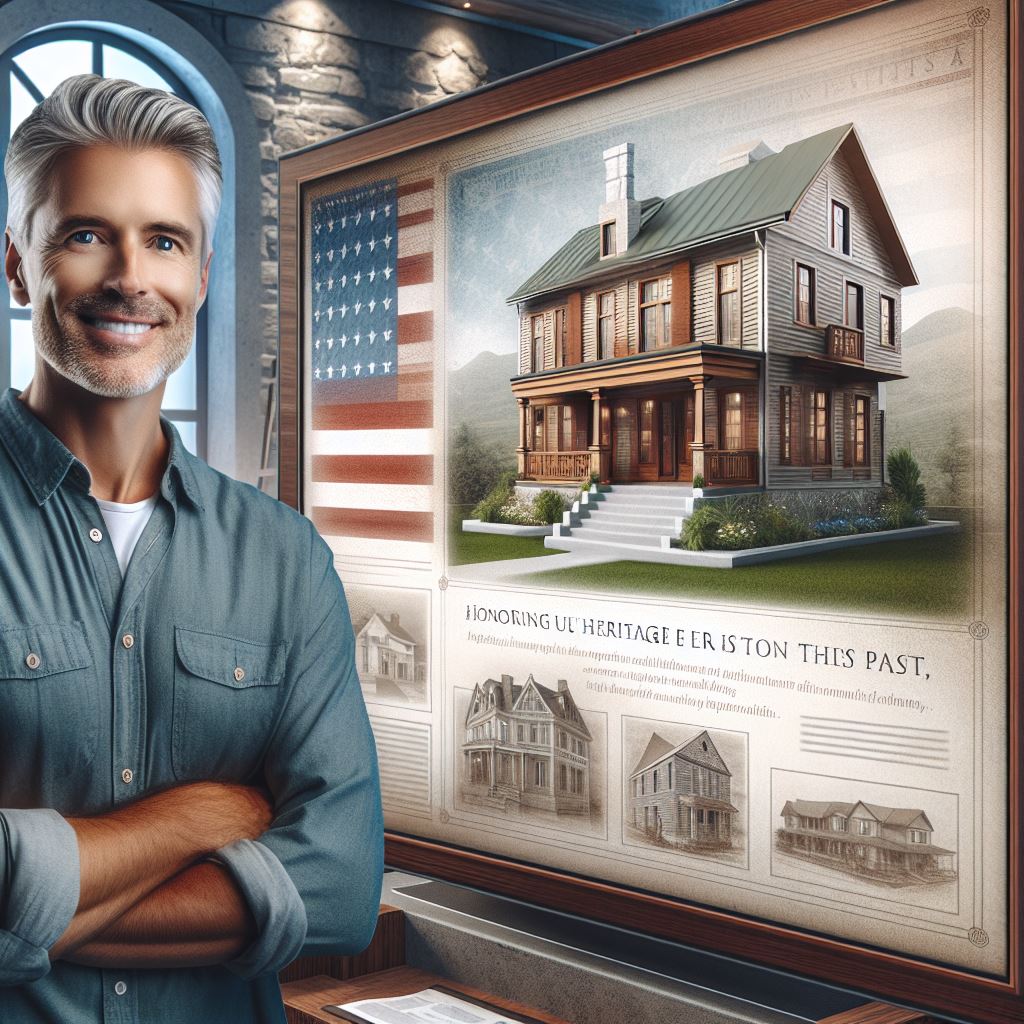Introduction
Historic preservation refers to the protection and conservation of buildings, structures, and landmarks that hold cultural, historical, or architectural significance.
Historic preservation plays a crucial role in maintaining our cultural heritage and identity.
It allows us to connect with the past and understand our roots while creating a sense of continuity and community.
Preserving historic homes not only helps retain the physical fabric and character of a place but also contributes to economic development through heritage tourism.
These buildings often serve as living museums, providing visitors with a glimpse into the past and generating revenue for local economies.
Furthermore, historic homes can inspire modern architectural design and sustainable living practices.
By blending historic features with contemporary amenities, homeowners can enjoy the best of both worlds – the charm of the past and the comfort of the present.
Historic preservation also fosters a sense of pride and ownership within communities, as residents become stewards of their shared history.
By maintaining and rehabilitating historic homes, neighborhoods can retain their character and attract new residents, enhancing property values and overall quality of life.
In essence, historic preservation in modern US homes is essential for cultural, economic, and environmental reasons.
By recognizing the value of our past, we can create a more sustainable and enriched future for generations to come.
Benefits of Historic Preservation
Preserving cultural heritage
- Historic preservation safeguards our rich history, traditions, and architectural treasures.
- Preserving cultural heritage allows future generations to understand and appreciate their roots.
- By maintaining historic homes, we ensure the preservation of our unique cultural identity.
Maintaining community identity
- Historic homes contribute to the distinctive character and charm of our neighborhoods.
- Preserving these properties maintains a sense of community and belonging.
- When we protect our historic homes, we protect our shared stories and memories.
Enhancing property value
- Historic homes often have higher property values due to their unique features and historical significance.
- Preserving these homes can attract buyers willing to pay a premium for their rarity and character.
- By investing in historic preservation, we can increase the overall value of our neighborhoods.
Promoting sustainable development
- Historic preservation encourages the reuse and revitalization of existing structures, promoting sustainability.
- Rather than constructing new homes, preserving existing ones reduces waste and energy consumption.
- Preserving historic homes aligns with sustainable development goals, benefiting both the environment and economy.
Fostering tourism and economic growth
- Historic neighborhoods attract tourists interested in experiencing our heritage and architecture first-hand.
- Preserving historic homes creates opportunities for businesses, such as bed and breakfasts and specialty shops.
- Tourism driven by historic preservation contributes to local economies and job creation.
In fact, historic preservation in modern US homes offers numerous benefits to individuals, communities, and economies.
By preserving our cultural heritage, maintaining community identity, enhancing property values, promoting sustainable development, and fostering tourism, we can create a more vibrant and sustainable future.
Read: 2024 US Market: Booming Condo Trends
Challenges in Historic Preservation
High costs involved
Preserving a historic home often comes with a hefty price tag.
Restoration and maintenance expenses can quickly add up, from specialized materials to skilled labor costs.
These financial burdens can be daunting for homeowners, especially when faced with other pressing expenses.
However, investing in preservation ensures the longevity and value of the property, making it a worthwhile endeavor in the long run.
Balancing modern needs with historic authenticity
Modern homeowners often seek to update their properties to meet contemporary standards of comfort and convenience.
Yet, preserving the authenticity and character of a historic home presents a delicate balance.
Striking this equilibrium requires careful consideration and creative solutions, such as integrating modern amenities while preserving original architectural features.
Achieving this balance honors the home’s heritage while accommodating the needs of its occupants.
Obtaining necessary permits and approvals
Navigating the bureaucratic landscape of obtaining permits and approvals for historic preservation projects can be a complex and time-consuming process.
Homeowners must adhere to strict regulations and guidelines set forth by local historic preservation boards and government agencies.
This entails extensive paperwork, inspections, and consultations with preservation experts.
Patience and perseverance are essential as homeowners work through the necessary channels to ensure compliance with regulations while preserving the integrity of their homes.
Addressing structural integrity and safety concerns
Historic homes may pose unique challenges regarding structural integrity and safety.
Aging foundations, deteriorating materials, and outdated building codes can compromise the safety of occupants.
Prioritizing structural assessments and necessary repairs is crucial to mitigate risks and ensure the longevity of the home.
Working with experienced contractors and preservation specialists can help identify and address potential hazards while preserving the home’s historic character.
Educating homeowners on preservation techniques
Many homeowners may lack awareness of proper preservation techniques and best practices.
Providing education and resources on historic preservation empowers homeowners to become stewards of their properties.
Workshops, seminars, and online resources can offer valuable insights into preservation methods, maintenance strategies, and available resources.
By fostering an understanding and appreciation for the importance of preservation, homeowners can contribute to the safeguarding of our cultural heritage for future generations.
Read: Remote Work Impact on US Home Design
Strategies for Incorporating Historic Preservation in Modern US Homes
Researching the history and architectural elements of the property
Researching the history and architectural elements of the property is the first step towards incorporating historic preservation in modern US homes.
The purpose of this research is to gain a comprehensive understanding of the home’s original design and construction.
It is important to investigate historical records, such as building permits, drawings, photographs, and any available documentation related to the property.
his research will shed light on the architectural style, building materials, and significant changes that might have occurred over time.
By understanding the historical context and architectural elements, homeowners can make informed decisions about which features to preserve and how to integrate modern updates without compromising the home’s historic integrity.
Consulting with preservation professionals
Engaging the expertise of preservation professionals is invaluable when it comes to incorporating historic preservation in modern US homes.
These professionals have specialized knowledge and experience in working with historic structures.
An architect or preservation consultant can provide a comprehensive assessment of the property and offer guidance on preservation techniques.
They can ensure that any modifications adhere to preservation guidelines and regulations.
Historians or architectural historians can help homeowners better understand the historical significance of their home and its role in the local community or broader context.
Conservators specialize in the conservation and restoration of historic materials, such as woodwork, plaster, or decorative finishes.
Their expertise can be particularly useful when deciding how to repair or preserve delicate architectural details.
By consulting with these professionals, homeowners can gain valuable insights and make informed decisions throughout the preservation process.
Identifying and preserving key historic features
Preserving key historic features is crucial for maintaining the authentic character and charm of a historic home.
These features represent the architectural and historical significance of the property and should be identified and protected.
Examples of key historic features include original millwork, ornamental plasterwork, stained glass windows, or unique architectural details.
These elements contribute to the overall historical integrity and should be carefully preserved.
When preserving these features, it is important to use appropriate conservation techniques and materials.
This may involve repairing or replicating damaged or missing elements using historically accurate methods and materials.
Preserving these features can strengthen the connection between the past and the present, allowing homeowners to appreciate the craftsmanship of a bygone era.
Utilizing sustainable and energy-efficient practices
Incorporating sustainable and energy-efficient practices into the preservation of historic homes aligns with the principles of responsible stewardship and environmental consciousness.
Preservation efforts should strive to enhance energy efficiency without compromising the historic fabric of the home.
This can be achieved through strategies such as proper insulation, upgraded HVAC systems, or solar panels discreetly integrated into the design.
Choosing sustainable materials for restoration or repairs, such as reclaimed wood or low VOC paints, can also contribute to a more environmentally friendly approach.
By incorporating these practices, homeowners can reduce their ecological footprint while preserving the unique character of their historic home for future generations.
Incorporating modern amenities while preserving historic charm
The successful integration of modern amenities in historic homes requires a thoughtful approach that respects the original design and preserves the historic charm.
This can be achieved by carefully selecting materials, fixtures, and finishes that harmonize with the existing architectural style.
For example, modern lighting fixtures can be chosen to complement the home’s historic ambiance.
When adding new features or making modifications, it is important to maintain a visual and functional balance.
Modern technologies can be discreetly integrated, such as hidden audio systems or smart home features that do not detract from the overall historic character.
Preserving the historic charm while incorporating modern amenities ensures that the home remains relevant, comfortable, and functional for contemporary living.
In summary, incorporating historic preservation in modern US homes involves thorough research, consultation with preservation professionals, preservation of key features, sustainable practices, and a careful integration of modern amenities.
These strategies allow homeowners to maintain the beauty and historical integrity of their homes while adapting them to contemporary lifestyles.
Read: US Market: Rise of Mixed-Use Properties

Case Studies: Successful Historic Preservation Projects
Example 1: Renovation of a historic farmhouse into a modern family home
In this case study, we explore the transformation of a historic farmhouse into a contemporary family residence.
The farmhouse, originally built in the late 1800s, required extensive preservation efforts to maintain its historic character while accommodating modern needs.
The project successfully blended the past and the present, resulting in a beautiful and functional home.
- The renovation team carefully documented and preserved the farmhouse’s original architectural details, such as the ornate cornices and window frames.
- Modern amenities were seamlessly incorporated into the design, including a spacious kitchen with state-of-the-art appliances.
- The project also involved the addition of new elements, such as a sunroom, to improve the livability of the farmhouse.
- The exterior of the farmhouse was revitalized with fresh paint and repairs to the aging roof and siding.
- Energy-efficient features, such as insulation and solar panels, were incorporated to minimize the home’s environmental impact.
Example 2: Restoration of a historic downtown building for commercial use
In this example, we delve into the successful restoration of a historic downtown building for commercial purposes.
Originally constructed in the early 1900s, the building had fallen into disrepair before undergoing a comprehensive preservation project.
The restoration of this structure not only revitalized a downtown landmark but also provided a functional space for businesses.
- Extensive research was conducted to uncover the building’s original architectural details, including its façade and decorative elements.
- Specialized craftsmen were employed to restore the delicate stonework and intricate woodwork throughout the building.
- The interior was reconfigured to accommodate modern office spaces, while still preserving the building’s historic charm.
- New infrastructure, such as electrical and plumbing systems, were seamlessly integrated to meet modern requirements.
- The restoration project complied with local conservation guidelines and showcased the building’s unique historical features.
Example 3: Adaptive reuse of a historic church as a community center
Our final case study explores the adaptive reuse of a historic church, transitioning it into a community center that serves multiple purposes.
Originally built in the early 1900s, the church had become obsolete for its original function but was given a new lease on life through this preservation project.
Today, it stands as a hub for community gatherings, events, and activities.
- Careful restoration of the church’s stained glass windows and ornate woodwork preserved its religious significance.
- The interior was reconfigured to accommodate multipurpose rooms, creating versatile spaces for various community activities.
- New features, such as a modern kitchen and accessible restrooms, were added to enhance functionality.
- The preservation project maintained the church’s architectural integrity while adapting it to meet updated building codes.
- The community center fosters a sense of belonging and provides a valuable space for social and educational events.
These case studies exemplify the successful integration of historic preservation into modern US homes, showcasing the ability to honor the past while embracing the needs of the present.
By preserving and repurposing historic structures, we not only protect our shared heritage but also create livable spaces that contribute to the vibrancy of our communities.
Read: Sustainable Living: US Market Adapts
Resources for Historic Preservation
Local and national historic preservation organizations
- National Trust for Historic Preservation: Offers resources, advocacy, and grants for historic preservation projects.
- State Historic Preservation Offices: Provide guidance, funding, and technical assistance at the state level.
- Local Preservation Commissions: Support preservation efforts and provide information on local preservation ordinances and incentives.
- Historic Preservation Nonprofits: Many organizations focus on specific regions or communities, assisting with preservation initiatives.
Government grants and financial incentives
- Federal Historic Preservation Tax Incentives: Offers tax credits for rehabilitation and restoration of historic properties.
- State and Local Grants: Governments provide financial assistance for historic preservation projects.
- Rehabilitation Investment Tax Credit: Tax credit available for qualified rehabilitation expenses on income-producing historic properties.
- Historic Homeowner Grant Programs: Some municipalities offer grants to homeowners for the preservation of historic homes.
Preservation workshops and educational programs
- Historic Preservation Training Centers: Offer workshops, courses, and certifications for professionals and enthusiasts.
- University Programs: Many universities have preservation programs that provide education in the field.
- Historic Preservation Conferences: Attend conferences to learn about new research, techniques, and best practices.
- Local Preservation Workshops: Communities often organize workshops on topics like restoration techniques and historic building materials.
Online resources and databases for historic property owners
- National Register of Historic Places: Access an online database of registered historic properties across the United States.
- PreservationDirectory.com: Provides a directory of historic preservation resources, including contractors and suppliers.
- Historic Property Research Tools: Websites like HistoricAerials.com offer access to historic maps and aerial photographs.
- Online Preservation Communities: Join online forums and social media groups to connect with other historic property owners.
These resources empower homeowners and professionals in their efforts to preserve and protect historic homes.
Conclusion
Historic preservation plays a crucial role in maintaining our cultural heritage and creating a sense of identity.
By preserving historic elements in modern US homes, we are able to connect with the past and appreciate the architectural and cultural significance of these structures.
As homeowners, it is important to recognize the value of historic preservation and consider preserving the unique features of our homes.
By doing so, we not only enhance the character and charm of our living spaces but also contribute to the preservation of our collective history for future generations.
Moreover, historic preservation goes hand in hand with sustainable development practices.
By reusing and repurposing existing buildings, we can reduce waste and minimize the environmental impact of new construction.
Preserving our architectural heritage allows us to create a more sustainable future that is grounded in our rich history.
Historic preservation is not just about preserving the past; it is about building a better future by connecting with our roots and creating sustainable living spaces.
Let us embrace the importance of historic preservation and make a positive impact on our communities and the world at large.




